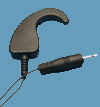|
|
Driver Alert Accessory
|
For use with MC-218, MC-223, MC-228 Alarms ... Stay Awake Device can be attached to your personal alarm for use while driving.
Converts multi-functional personal alarms into a very effective driver sleep alarm (no doze alarm).
Ear piece monitors the head angle to determine if driver is falling asleep and sounds the alarm.
|

|
· Head tilt Attachment
· Lightweight ear piece
· 41" Length (105cm)
* * Alarm sold separately * *
|
|
Drowsy Driving and Automobile Crashes
Driving while sleepy is a risky behavior that leads to thousands of automobile crashes each year.
The National Highway Traffic Safety Administration estimates that each year drowsy driving results in 1,550 deaths and 71,000 injuries with 55% of these crashes involving drivers 25 years old and younger.
The following groups of driver are at highest risk (although no one is immune):
- Young males (ages 16 to 29).
- Shift workers working at night, anyone working long or irregular hours.
- People with untreated sleep apnea syndrome (SAS) and narcolepsy.
Fatigue impairs driver reaction time, care and attention, thought processing and short-term memory.
At one moment you're aware of feeling drowsy and in a split second you can be asleep -- an incredibly dangerous situation.
Common "stay awake" behaviors, such as exercising, turning on the radio, or opening the windows, have not been shown to prevent sleep attacks.
Drowsiness ultimately leads to the inability to resist falling asleep at the wheel.
Although an effective alerting device may prevent a crash, any driver who falls asleep once is likely to fall asleep again.
Sleepy drivers, must view any wake-up alert as an indication of impairment; a signal to stop driving (e.g., change drivers, get a motel or find a rest stop) and get adequate sleep before driving again.
This report presents the results of a literature review and opinions of the NHTSA Expert Panel on Driver Fatigue and Sleepiness regarding key issues involved in the problem.
|
|


